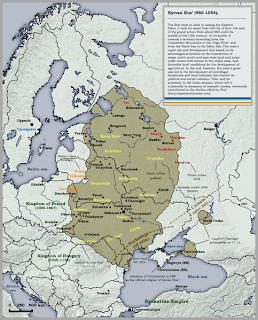 |
| The Kievan Rus' civilization was a federation of East Slavic tribes ruled by the Rurik dynasty. The civilization spanned from the late 9th to the mid-13th century. source |
 |
| Oleg of Novgorod. As prince of the Rurik dynasty in Novgorod, he took the region of Kiev and built the Kievan Rus' civilization. Oleg died between 912 and 922. source |
 | |||||
| The rulers of the Kievan Rus' were members of the Rurik dynasty. Icon of Saint Prince Vladimir, who exapnded his realm from the Baltic Sea to modern-day Ukraine, and converted the Kievs to Christianity. 16th century. source |
 | ||
| "Srebrenik" of Vladimir I the Great. source |
 |
| The Golden Gate of Vladimir: erected in 1164. Served as a fortress and as a main entrance to the city of Vladimir. Saw times of war, the passage of future monarchs, and withstood the Mongol-Tartar attacks. source |
 |
| source |
The Russkaya Pravda is the legal code of the Kievan Rus' and Rus' principalities. Cultural links to the Byzantine Empire are not reflected in Rus' legislation; in fact, the Kievan Rus' code had a far more humane approach to law making than any other Eastern European civilization, with a total absence of capitol or corporal punishment.
Excepts from The Russkaya Pravda: Short Version. source
Article 1.
| If a man kills a man, the brother is to avenge his brother; the son,
his father; or the father, his son; or nephews, their uncles; and if
there is no avenger [the murderer pays] forty grivnas fine; if [the
killed man] is a Kievan Russian, or a member of the druzhina, or a
merchant, or a sheriff, or an agent of the prince, or even a serf, or a
Novgorodian Russian, the fine is forty grivnas. Article 7. For the moustache twelve grivnas; and for the beard twelve grivnas Article 30. And if anyone damages or burns a prince's bee hive, three grivnas. Article 42. The following is the tax collecting custom: the collectors [during their journey] should receive seven buckets of malt, a ram or some other meat or two nogatas; and on Wednesday one rezana or cheese; the same on Friday; and as much bread and millet as they can eat; and two chickens per day; and shelter for four of their horses and feed for them, as much as they can eat; the collectors should [collect] sixty grivnas, ten rezanas, twelve veveritsas, and a grivna in advance; and during Lent collectors should receive fish and should get seven rezanas for fish; during a week they should receive fifteen kunas and food as much as they can eat; tax collectors should complete their task in one week; such is Iaroslav's decree. The Primary Chronicle is a history of the Kiev people from 850 to 1110, compiled in 1130 by the Kievan Rus'. Its a widely used source when discussing the history, the culture, and politics of the East Slavs. source | ||||||||||

No comments:
Post a Comment